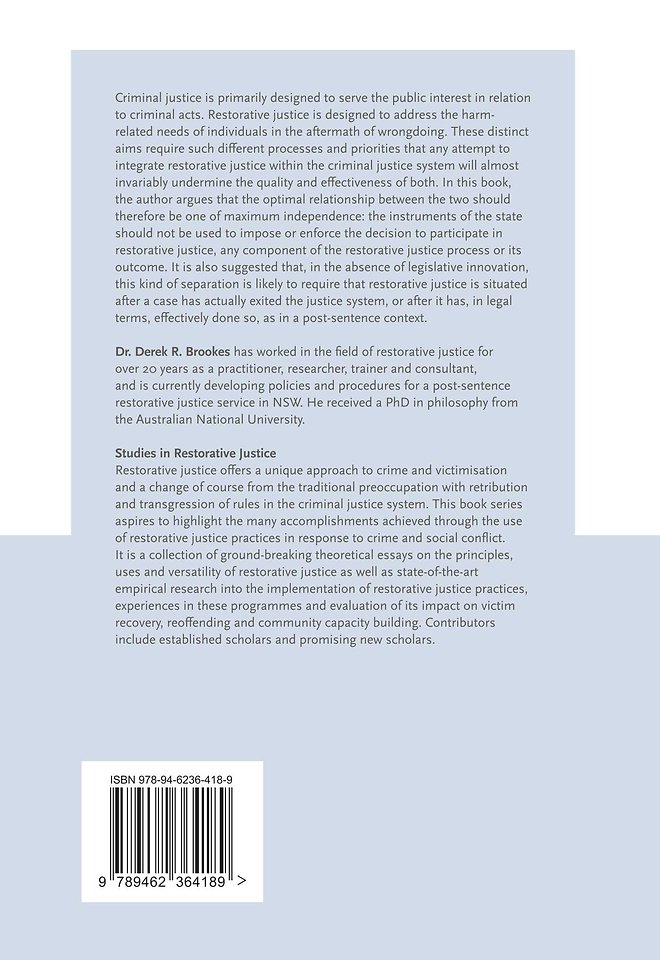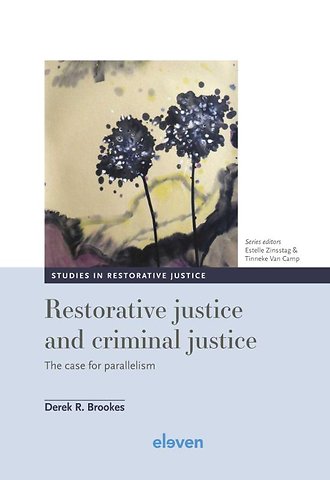Restorative justice and criminal justice
The case for parallelism
Gebonden Engels 2023 1e druk 9789462364189Samenvatting
Criminal justice is primarily designed to serve the public interest in relation to criminal acts. Restorative justice is designed to address the harm-related needs of individuals in the aftermath of wrongdoing. These distinct aims require such different processes and priorities that any attempt to integrate restorative justice within the criminal justice system will almost invariably undermine the quality and effectiveness of both.
In this book, the author argues that the optimal relationship between the two should therefore be one of maximum independence: the instruments of the state should not be used to impose or enforce the decision to participate in restorative justice, any component of the restorative justice process or its outcome. It is also suggested that, in the absence of legislative innovation, this kind of separation is likely to require that restorative justice is situated after a case has actually exited the justice system, or after it has, in legal terms, effectively done so, as in a post-sentence context.
Trefwoorden
herstelrecht herstelgerichte rechtvaardigheid parallelisme strafrecht rechtsfilosofie slachtofferrechten daderbehandeling ethiek publiek versus privé belang rechtvaardigheid verantwoordelijkheid slachtoffers implementatie daders mediatie gelijkheid integratie proportionaliteit rechtspraak due process vertrouwen beleid zelfbeschikking privacybescherming legitimiteit conflictoplossing oprechtheid integriteit transformatieve rechtvaardigheid
Trefwoorden
Specificaties
Lezersrecensies
Inhoudsopgave
U kunt van deze inhoudsopgave een PDF downloaden
Acknowledgements xii
Preface xiv
1 Introduction 1
1.1 The debate 1
1.1.1 Integrationism 1
1.1.2 Maximalism 2
1.1.3 Substitutionism 5
1.1.4 Resistance to integrationism 7
1.1.5 Parallelism 10
1.1.6 Logistical questions 13
1.2 The case 14
1.2.1 Scope 14
1.2.2 Terminology 14
1.2.3 Methodology 18
1.2.4 Structure 19
2 Foundations 23
2.1 Public vs. private interest 23
2.1.1 Complementary roles 24
2.1.2 Legitimacy of criminal justice 25
2.1.3 Who owns crime? 32
2.1.4 The social contract 34
2.1.5 Simulating informal regulation 36
2.1.6 Balance between victim and offender 39
2.1.7 Public interest and state coercion 41
2.2 Passive vs. active responsibility 43
2.2.1 Active superior to passive 43
2.2.2 Active supersedes passive 44
2.2.3 Active mitigates passive 46
2.2.4 Active secondary to passive 48
2.2.5 Active compromised by passive 51
2.2.6 Active subordinated to passive 53
2.2.7 Passive does not imply unwilling 56
2.3 Public vs. private censure 57
2.3.1 Role of public censure 57
2.3.2 An integrationist critique 58
2.3.3 Parallelist perspective 60
2.3.4 Possible responses 65
3 Implementation 71
3.1 Guiding principles 71
3.1.1 Introduction 71
3.1.2 Explanation 72
3.2 Logistics 98
3.2.1 Victim-initiated referrals 98
3.2.2 Offender-initiated referrals 100
3.2.3 Funding 103
3.2.4 Implementation and evaluation 108
3.3 Mainstreaming 109
3.3.1 Potential for expansion 109
3.3.2 Requirements for mainstreaming 110
3.3.2.1 Autonomous 111
3.3.2.2 Essential 116
4 Advantages 119
4.1 Equality 119
4.1.1 Equality for offenders 119
4.1.2 Equality for victims 122
4.1.3 Inequality in maximalism 125
4.2 Proportionality 126
4.2.1 Reasonableness 126
4.2.2 Punitive Limits 127
4.2.3 Disparity between the limits 130
4.2.4 Incommensurability 132
4.3 Due process 137
4.3.1 Legal representation 137
4.3.2 Presumption of innocence 141
4.4 Boundaries 143
4.4.1 Privacy 143
4.4.2 Conceptions of the good 144
4.4.3 Net widening 146
4.4.4 Net tightening 147
4.5 Sincerity 149
4.5.1 Violation of moral agency 149
4.5.2 Moral corrosiveness 152
4.5.3 Taking ethics seriously 153
4.5.4 Possible responses 157
4.6 Trust 162
4.6.1 Justifiable scepticism 162
4.6.2 Pedagogical props 164
4.6.3 Possible responses 168
4.7 Integrity 176
4.7.1 Criteria for success 176
4.7.1.1 Completed agreement 177
4.7.1.2 Genuine remorse 179
4.7.1.3 Forgiveness 181
4.7.1.4 Reporting issues 183
4.7.2 Timescales 187
4.7.3 Caseload pressures 189
4.7.4 Authority 191
4.8 Inclusiveness 195
4.8.1 Institutional contagion 195
4.8.2 Potential for transformative justice 200
4.9 Self-Determination 206
4.9.1 Circle sentencing 206
4.9.2 Deep colonising 209
4.9.3 Conferencing 214
4.9.4 A Parallelist alternative 222
4.9.5 De-subjectification 230
5 Challenges 235
5.1 Victims 235
5.1.1 Limited access to restorative justice 235
5.1.2 Extended delays 239
5.1.3 Risk management issues 243
5.2 Offenders 244
5.2.1 Risk of self-incrimination 244
5.2.2 Risk of appeals or litigation 246
5.2.3 Lower participation rates 248
5.2.4 Voluntariness 249
5.2.5 Risk of overburdening 250
5.3 Criminal justice 251
5.3.1 Caseload pressures 251
5.3.2 Non-RJ diversionary programmes 252
5.3.3 Reducing penal control 255
5.3.4 State underreach 256
5.3.5 Parallelism as a driver for reform 261
6 Conclusion 263
Bibliography 267
Index 287
Anderen die dit boek kochten, kochten ook
Rubrieken
- advisering
- algemeen management
- coaching en trainen
- communicatie en media
- economie
- financieel management
- inkoop en logistiek
- internet en social media
- it-management / ict
- juridisch
- leiderschap
- marketing
- mens en maatschappij
- non-profit
- ondernemen
- organisatiekunde
- personal finance
- personeelsmanagement
- persoonlijke effectiviteit
- projectmanagement
- psychologie
- reclame en verkoop
- strategisch management
- verandermanagement
- werk en loopbaan









